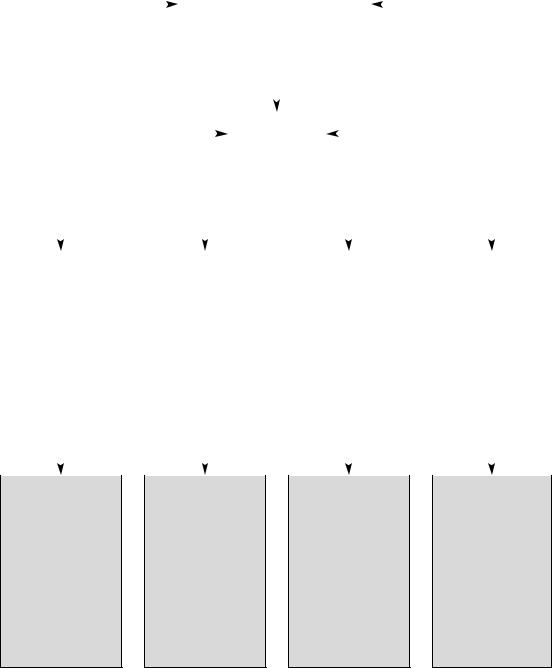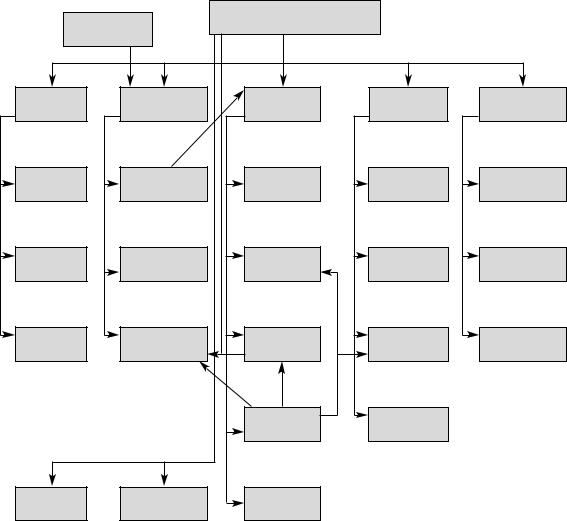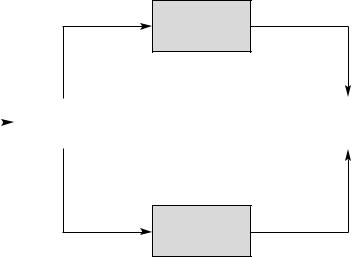
Армстронг
.pdfxxii |
List of tables |
|
42.1 |
Economic theories explaining pay levels |
626 |
42.2 |
Summary of payment and incentive arrangements for sales staff |
637 |
42.3 |
Comparison of shopfloor payment-by-result schemes |
639 |
43.1 |
Examples of reward strategies and their derivation |
656 |
44.1 |
Comparison of approaches to job evaluation |
669 |
45.1 |
Summary of sources of market data |
686 |
46.1 |
Summary analysis of different grade and pay structures |
699 |
47.1 |
Comparison of individual contingent pay schemes |
722 |
50.1 |
Contrasting dimensions of industrial relations and HRM |
761 |
54.1 |
Communication areas and objectives |
820 |
59.1 |
Computer system problems and solutions |
894 |

About the author
Michael Armstrong is an honours graduate in economics from the London School of Economics, a Companion of the Chartered Institute of Personnel and Development and a Fellow of the Institute of Management Consultancy.
This book is largely based on Michael Armstrong’s hands-on experience as a personnel practitioner, initially in the engineering industry, specializing in industrial relations, and then in the engineering and food industries as an employee development specialist.
For 12 years he was an executive director with responsibility for HR in a large publishing firm and for three years of that period also acted as general manager for an operating division. For a further 10 years he headed up the HR consultancy division of Coopers & Lybrand. He is Managing Partner of e-reward.uk and also practises as an independent consultant. This experience has been supplemented recently by a number of research projects carried out on behalf of the Chartered Institute of Personnel and Development. These covered the personnel function’s contribution to the bottom line, strategic HRM, incentive pay, job evaluation, team rewards, broadbanded pay structures, and performance management. He was Chief Examiner Employee Reward for the CIPD from 1997–2001.
His publications for Kogan Page include Reward Management, Performance Management, How to Be an Even Better Manager, A Handbook of Management Techniques and A Handbook of Employee Reward, Management and Leadership.

Preface
This tenth edition of A Handbook of Human Resource Management Practice contains many additions and revisions. It refers to major developments in HR practice in the last two to three years such as the development of the theory and practice of human capital management, talent management and approaches to learning and development, all covered in new or substantially revised chapters. Reference is also made to a number of significant research projects including those conducted by the CIPD, IES and e-reward. Chapters on the following subjects have been either wholly replaced or extensively revised in the light of new concepts of good practice, the experience of the author as a practitioner and the outcomes of research:
●human resource management;
●role of the HR function;
●role of the HR practitioner;
●strategic human resource management;
●competency-based HRM;
●the delivery of learning and training;
●performance management;
●reward management fundamentals;
●grade and pay structures.
The plan of the handbook is illustrated in the ‘route map’ shown in Figure 0.1.

xxvi Preface
3 |
Role of HR function |
|
|
|
|
|
|
I People management |
|
|
|
6 International HRM |
||||||||||||||
4 Role of HR practitioner |
|
|
|
|
1 Human resource management |
|
|
|
|
|
|
|
||||||||||||||
5 Role of line manager |
|
|
|
|
2 Human capital management |
|
|
|
|
|
|
|
|
|||||||||||||
|
|
|
|
|
|
|
|
|
|
|
|
|
|
|
|
|
|
|
|
|
|
|
|
|
||
|
|
|
|
|
|
|
|
|
|
|
|
|
|
|
|
|
|
|
|
|
|
|
|
|
||
|
II HRM processes |
|
|
|
|
|
|
|
|
|
|
|
|
|
|
|
|
|
Factors affecting HRM strategy |
|||||||
7 |
Strategic HRM |
|
|
|
|
|
|
|
|
|
|
|
|
|
|
|
|
|
|
|
policy and practice |
|||||
|
|
|
|
|
|
|
|
|
|
|
|
|
|
|
|
|
|
|
|
|
|
|
||||
8 |
HR strategies |
|
|
|
|
|
|
|
|
|
|
|
|
|
|
|
|
III Work and employment |
||||||||
9 |
Developing HR strategies |
|
|
|
|
|
|
|
|
|
|
|
|
|
|
|
|
14 |
The nature of work |
|||||||
10 |
HRM policies |
|
|
|
|
|
|
|
HRM strategy, |
|
|
|
|
|
15 |
The employment relationship |
||||||||||
11 |
Competency-based HRM |
|
|
|
|
|
|
|
policy and |
|
|
|
|
|
16 The psychological contract |
|||||||||||
|
|
|
|
|
|
|
|
|
|
|
|
|||||||||||||||
12 |
Knowledge management |
|
|
|
|
|
|
|
practice |
|
|
|
|
|
IV |
Organizational behaviour |
||||||||||
13 |
Analysing roles, |
|
|
|
|
|
|
|
|
|
|
|
|
|
|
|
|
17 |
Characteristics of people |
|||||||
|
|
|
|
|
|
|
|
|
|
|
|
|
|
|
|
|||||||||||
|
competencies and skills |
|
|
|
|
|
|
|
|
|
|
|
|
|
|
|
|
18 |
Motivation |
|
|
|||||
|
|
|
|
|
|
|
|
|
|
|
|
|
|
|
|
|
|
|
|
19 Commitment and engagement |
||||||
|
|
|
|
|
|
|
|
|
|
|
|
|
|
|
|
|
|
|
|
20 |
How organizations function |
|||||
|
|
|
|
|
|
|
|
|
|
|
|
|
|
|
|
|
|
|
|
21 |
Organizational culture |
|||||
|
|
|
|
|
|
|
|
|
|
|
|
|
|
|
|
|
|
|
|
|
|
|
||||
|
|
|
|
|
|
|
|
|
|
|
|
|
|
|
|
|
|
|
|
|
|
|||||
|
|
|
|
|
|
|
|
|
|
|
|
|
|
|
|
|
|
|
|
|
|
|
|
|
|
|
|
|
|
|
|
|
|
|
|
|
|
|
|
|
|
|
|
|
|
|
|
|
|
|
|
|
|
V Organization |
|
VI People resourcing |
|
|
VII Performance |
|
|
VIII Human resource |
||||||||||||||||||
|
|
|
|
25 |
Human resource |
|
|
|
management |
|
|
|
development |
|||||||||||||
22 |
Organization |
|
|
|
|
|
|
|
|
|
|
|
|
|
|
|
|
|||||||||
|
design |
|
|
planning |
|
|
32 |
Basis of |
|
|
35 |
Strategic HRD |
||||||||||||||
23 |
Job and role |
|
26 |
Talent |
|
|
|
performance |
|
|
36 |
Organizational |
||||||||||||||
|
design |
|
|
management |
|
|
|
management |
|
|
|
learning |
||||||||||||||
24 |
Organization |
|
27 |
Recruitment and |
|
|
33 Performance |
|
|
37 |
How people learn |
|||||||||||||||
|
development |
|
|
selection |
|
|
|
management |
|
|
38 |
Learning and |
||||||||||||||
|
|
|
|
28 |
Selection tests |
|
|
|
processes |
|
|
|
development |
|||||||||||||
|
|
|
|
29 |
Introduction to the |
|
|
34 |
360-degree |
|
|
39 |
E-learning |
|||||||||||||
|
|
|
|
|
organization |
|
|
|
feedback |
|
|
40 |
Management |
|||||||||||||
|
|
|
|
30 |
Release from the |
|
|
|
|
|
|
|
|
|
|
|
|
|
development |
|||||||
|
|
|
|
|
organization |
|
|
|
|
|
|
|
|
|
|
|
|
41 |
Learning and |
|||||||
|
|
|
|
|
|
|
|
|
|
|
|
|
|
|
|
|
|
|
|
|
|
|
|
|
development |
|
|
|
|
|
|
|
|
|
|
|
|
|
|
|
|
|
|
|
|
|
|
|
|
|
|
strategies |
|
|
|
|
|
|
|
|
|
|
|
|
|
|
|
|
|
|
|
|
|
|
|
|
|
|||
|
|
|
|
|
|
|
|
|
|
|
|
|
|
|
|
|
|
|
|
|
|
|
||||
|
|
|
|
|
|
|
|
|
|
|
|
|
|
|
|
|
|
|
|
|
|
|
|
|
|
|
|
|
|
|
|
|
|
|
|
|
|
|
|
|
|
|
|
|
|
|
|
|
|
|
|
|
|
|
IX Rewarding |
|
|
X Employee |
|
|
XI Health, safety |
|
|
XII Employment and |
||||||||||||||||
|
people |
|
|
|
|
relations |
|
|
|
and welfare |
|
|
|
HRM services |
||||||||||||
42 |
Reward |
50 |
Framework of |
|
|
55 Health and safety |
57 |
Employment |
||||||||||||||||||
|
management |
|
employee relations |
56 |
Welfare services |
|
|
|
practices |
|||||||||||||||||
43 |
Strategic reward |
51 |
Employee relations |
|
|
|
|
|
|
|
|
|
|
58 |
HRM procedures |
|||||||||||
44 |
Job evaluation |
|
processes |
|
|
|
|
|
|
|
|
|
|
59 |
Computerised |
|||||||||||
45 |
Market rate |
52 |
Negotiating and |
|
|
|
|
|
|
|
|
|
|
|
|
|
HR information |
|||||||||
|
analysis |
|
bargaining |
|
|
|
|
|
|
|
|
|
|
|
|
|
systems |
|||||||||
46 |
Grade and pay |
53 |
Employee voice |
|
|
|
|
|
|
|
|
|
|
|
|
|
|
|
||||||||
|
structures |
54 |
Communications |
|
|
|
|
|
|
|
|
|
|
|
|
|
|
|
||||||||
47Contingent pay
48Employee benefits
49Managing reward systems
Figure 0.1 Route map

Part I
Managing people
This part underpins the rest of the Handbook. It deals with the approaches and philosophies that affect how people are managed in organizations, the roles of the HR function and its members, and the special considerations that affect international people management. The term ‘people management’ embraces the two related concepts of human resource management (HRM) and human capital management (HCM), which are defined and explained in the first two chapters. These have virtually replaced the term ‘personnel management’, although the philosophies and practices of personnel management still provide the foundations for the philosophy and practices of HRM and HCM. The relationships between these aspects of people management are modelled in Figure 0.2.

2 Managing people
People management
The policies and practices which govern how people are managed and developed in organizations.
|
|
|
|
|
|
|
|
Human resource management |
|
|
|
|
Human capital management |
||
‘A strategic and coherent approach to the |
|
|
|
|
‘An approach to obtaining, analysing and |
||
management of an organization’s most |
|
|
|
|
reporting on data which informs the direc- |
||
valued assets – the people working there |
|
|
|
|
tion of value-adding people management |
||
who individually and collectively contribute |
|
|
|
|
strategic investment and operational deci- |
||
|
|
|
|
||||
to the achievement of its objectives.’ |
|
|
|
|
sions at corporate level and at the level of |
||
|
|
|
|
|
|
front line management.’ |
|
|
|
|
|
|
|
|
|
|
|
|
|
|
|
|
|
Personnel management
‘Personnel management is concerned with obtaining, organizing and motivating the human resources required by the enterprise.’
(Armstrong, 1977)
Figure 0.2 Relationship between aspects of people management

1
Human resource management
The terms ‘human resource management’ (HRM) and ‘human resources’ (HR) have largely replaced the term ‘personnel management’ as a description of the processes involved in managing people in organizations. The concept of HRM underpins all the activities described in this book, and the aim of this chapter is to provide a framework for what follows by defining the concepts of HRM and an HR system, describing the various models of HRM and discussing its aims and characteristics. The chapter continues with a review of reservations about HRM and the relationship between HRM and personnel management and concludes with a discussion of the impact HRM can make on organizational performance.
HUMAN RESOURCE MANAGEMENT DEFINED
Human resource management is defined as a strategic and coherent approach to the management of an organization’s most valued assets – the people working there who individually and collectively contribute to the achievement of its objectives.
Storey (1989) believes that HRM can be regarded as a ‘set of interrelated policies with an ideological and philosophical underpinning’. He suggests four aspects that constitute the meaningful version of HRM:
4 Managing people
1.a particular constellation of beliefs and assumptions;
2.a strategic thrust informing decisions about people management;
3.the central involvement of line managers; and
4.reliance upon a set of ‘levers’ to shape the employment relationship.
HUMAN RESOURCE SYSTEM
Human resource management operates through human resource systems that bring together in a coherent way:
●HR philosophies describing the overarching values and guiding principles adopted in managing people.
●HR strategies defining the direction in which HRM intends to go.
●HR policies, which are the guidelines defining how these values, principles and the strategies should be applied and implemented in specific areas of HRM.
●HR processes consisting of the formal procedures and methods used to put HR strategic plans and policies into effect.
●HR practices comprising the informal approaches used in managing people.
●HR programmes, which enable HR strategies, policies and practices to be implemented according to plan.
Becker and Gerhart (1996) have classified these components into three levels: the system architecture (guiding principles), policy alternatives and processes and practices.
See Figure 1.1.
MODELS OF HRM
The matching model of HRM
One of the first explicit statements of the HRM concept was made by the Michigan School (Fombrun et al, 1984). They held that HR systems and the organization structure should be managed in a way that is congruent with organizational strategy (hence the name ‘matching model’). They further explained that there is a human resource cycle (an adaptation of which is illustrated in Figure 1.2), which consists of four generic processes or functions that are performed in all organizations. These are:
1.selection – matching available human resources to jobs;

|
|
Human resource management |
5 |
|||
|
|
HUMAN RESOURCE |
|
|
|
|
Human capital |
MANAGEMENT |
|
|
|
||
management |
|
|
|
|
||
Organization |
Resourcing |
HR |
Reward |
Employee |
|
|
development |
management |
relations |
|
|||
|
|
|
||||
Design |
Human resource |
Organizational |
Job evaluation/ |
Industrial |
|
|
planning |
learning |
Market surveys |
relations |
|
||
|
|
|||||
Development |
Recruitment and |
Individual |
Grade and pay |
Employee voice |
||
selection |
learning |
structures |
||||
|
|
|
||||
Job/role |
Talent |
Management |
Contingent pay |
Communications |
||
design |
management |
development |
||||
|
|
|
||||
|
|
Performance |
Employee |
|
|
|
|
|
management |
benefits |
|
|
|
Health/safety |
HR services |
Knowledge |
|
|
|
|
and welfare |
management |
|
|
|
||
|
|
|
|
|||
Figure 1.1 HRM activities
2.appraisal – performance management;
3.rewards – ‘the reward system is one of the most under-utilized and mishandled managerial tools for driving organizational performance’; it must reward short as well as long-term achievements, bearing in mind that ‘business must perform in the present to succeed in the future’;
4.development – developing high quality employees.

6 Managing people
Rewards
Selection |
|
|
Performance |
|
Performance |
|
|
management |
|
||
|
|
|
|
|
|
|
|
|
|
|
|
Development
Figure 1.2 The Human Resource Cycle (adapted from Fombrun et al, 1984)
The Harvard framework
The other founding fathers of HRM were the Harvard School of Beer et al (1984) who developed what Boxall (1992) calls the ‘Harvard framework’. This framework is based on the belief that the problems of historical personnel management can only be solved:
when general managers develop a viewpoint of how they wish to see employees involved in and developed by the enterprise, and of what HRM policies and practices may achieve those goals. Without either a central philosophy or a strategic vision – which can be provided only by general managers – HRM is likely to remain a set of independent activities, each guided by its own practice tradition.
Beer and his colleagues believed that ‘Today, many pressures are demanding a broader, more comprehensive and more strategic perspective with regard to the organization’s human resources.’ These pressures have created a need for: ‘A longer-term perspective in managing people and consideration of people as potential assets rather than merely a variable cost.’ They were the first to underline the HRM tenet that it belongs to line managers. They also stated that: ‘Human resource management involves all management decisions and action that affect the nature of the relationship between the organization and its employees – its human resources.’
